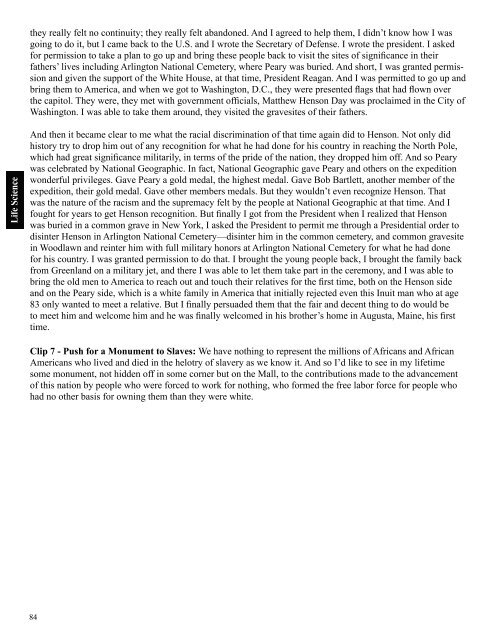ScienceMakers Toolkit Manual - The History Makers
ScienceMakers Toolkit Manual - The History Makers
ScienceMakers Toolkit Manual - The History Makers
Create successful ePaper yourself
Turn your PDF publications into a flip-book with our unique Google optimized e-Paper software.
Life Science<br />
they really felt no continuity; they really felt abandoned. And I agreed to help them, I didn’t know how I was<br />
going to do it, but I came back to the U.S. and I wrote the Secretary of Defense. I wrote the president. I asked<br />
for permission to take a plan to go up and bring these people back to visit the sites of signifi cance in their<br />
fathers’ lives including Arlington National Cemetery, where Peary was buried. And short, I was granted permission<br />
and given the support of the White House, at that time, President Reagan. And I was permitted to go up and<br />
bring them to America, and when we got to Washington, D.C., they were presented fl ags that had fl own over<br />
the capitol. <strong>The</strong>y were, they met with government offi cials, Matthew Henson Day was proclaimed in the City of<br />
Washington. I was able to take them around, they visited the gravesites of their fathers.<br />
And then it became clear to me what the racial discrimination of that time again did to Henson. Not only did<br />
history try to drop him out of any recognition for what he had done for his country in reaching the North Pole,<br />
which had great signifi cance militarily, in terms of the pride of the nation, they dropped him off. And so Peary<br />
was celebrated by National Geographic. In fact, National Geographic gave Peary and others on the expedition<br />
wonderful privileges. Gave Peary a gold medal, the highest medal. Gave Bob Bartlett, another member of the<br />
expedition, their gold medal. Gave other members medals. But they wouldn’t even recognize Henson. That<br />
was the nature of the racism and the supremacy felt by the people at National Geographic at that time. And I<br />
fought for years to get Henson recognition. But fi nally I got from the President when I realized that Henson<br />
was buried in a common grave in New York, I asked the President to permit me through a Presidential order to<br />
disinter Henson in Arlington National Cemetery—disinter him in the common cemetery, and common gravesite<br />
in Woodlawn and reinter him with full military honors at Arlington National Cemetery for what he had done<br />
for his country. I was granted permission to do that. I brought the young people back, I brought the family back<br />
from Greenland on a military jet, and there I was able to let them take part in the ceremony, and I was able to<br />
bring the old men to America to reach out and touch their relatives for the fi rst time, both on the Henson side<br />
and on the Peary side, which is a white family in America that initially rejected even this Inuit man who at age<br />
83 only wanted to meet a relative. But I fi nally persuaded them that the fair and decent thing to do would be<br />
to meet him and welcome him and he was fi nally welcomed in his brother’s home in Augusta, Maine, his fi rst<br />
time.<br />
Clip 7 - Push for a Monument to Slaves: We have nothing to represent the millions of Africans and African<br />
Americans who lived and died in the helotry of slavery as we know it. And so I’d like to see in my lifetime<br />
some monument, not hidden off in some corner but on the Mall, to the contributions made to the advancement<br />
of this nation by people who were forced to work for nothing, who formed the free labor force for people who<br />
had no other basis for owning them than they were white.<br />
84










